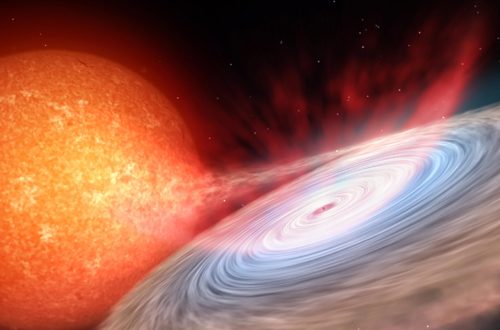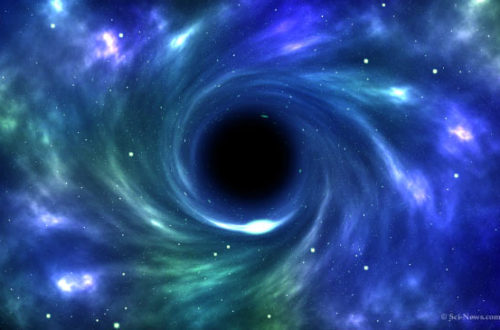My name is Dimitris Kantzas and I am a PhD student in Sera’s group. My research is focused on studying the multiwavelength radiation emitted in the vicinity of accreting black holes in order to better understand how these sources radiate, where exactly this radiation originates and if this radiation affects the physics and the morphology of these accreting black holes and their local environments.
But what are black holes? Where are they located, and how can we detect them? Black holes are regions of the spacetime with a very strong gravitational potential that doesn’t allow anything to escape, not even light. Black holes are everywhere in the Universe and we can only determine their presence indirectly by observing the effects they have on their environments. We believe that a massive black hole, with a mass of a million to a billion times the mass of the Sun, lies at the center of every individual galaxy. In particular, we use the observed radiation produced as a result of the interaction between the black hole and the surrounding matter to study them. Influenced by the gravitational potential of the black hole, material from nearby stars can orbit the black hole creating a disk of matter around it, known as the accretion disk. The accretion disk is a strong source of electromagnetic radiation, and observing this radiation can provide key insights into the nature of the black hole at its center. In some circumstances, matter from the accretion disk is launched from each face of the disk in the form of a fast-moving outflow. These outflows have extremely high velocities that are comparable to the speed of light and travel towards the intergalactic medium which surrounds the galaxy. These fast-moving outflows are referred to as relativistic jets and can remain focused for distances of a million times, or larger, than the size of the black hole. The actual composition of these jets is still debated, but they seem to be governed by particles and light. Studying these jets can give further insight into the nature of black holes.
Systems with black holes, accretion disks and jets can also be found on smaller spatial scales, and with less massive black holes compared to those described above. In particular, there are black holes located inside galaxies, even in our Galaxy, that weigh only a few times more than the sun. Some of these black holes are coupled to a companion star. Despite this, the physics governing such coupled systems remains the same as these black holes have been observed to accrete mass from the companion and occasionally produce relativistic jets. Such a system is depicted in the artistic sketch shown below of Cygnus X-1, the first ever detected Galactic black hole.

Cygnus X-1 consists of a 15 solar mass black hole and a 20 solar mass supergiant star as a companion. The black hole accretes mass from the companion star and launches a relativistic jet towards the interstellar medium. This system is a luminous source at X-rays and consequently has been classified as a black hole X-ray binary with a massive companion. The existence of the accreting black hole can be revealed by these X-rays, which originate from the accretion disk and the launched matter. Let’s now see how this radiation is produced, especially inside the jets.
Protons and electrons travel from the accretion disk to the jet. While traveling along the jet, these particles gain energy and thus travel even faster, with velocities that reach 0.999 times the speed of light. The mechanisms by which the particles are accelerated to such high velocities are currently not well understood. Determining these acceleration mechanisms is important in order to better understand the radiation emitted by the jets.
These particles, and in general every charged particle, interact with the magnetic field located inside the jet in such a way that they lose energy. The energy lost by the particles is carried by the photons produced by the interaction between the particle and the magnetic field and ranges between radio and X-rays. In addition, γ rays have also been detected in such systems. The origin of these γ rays is more strongly debated but nevertheless, two scenarios seem to be the most plausible. In the first scenario, electrons with high enough energy compared to the energy they carry while at rest (rest mass, 511keV), interact with photons originating from either inside the jet or outside of it. This interaction is actually an inelastic collision that transfers energy to the photons, making them detectable by γ-ray telescopes. Alternatively, another possible scenario is when protons with high enough energy compared to their rest mass (938MeV) interact with other protons or photons from inside or outside the jet. This process is very similar to the one described for the electrons as eventually γ-ray photons are produced. The difference in the latter scenario is that other particles are initially produced before the γ rays, such as pions and muons, that eventually decay into the γ rays we observe. My research aims to distinguish these two scenarios for different Galactic or supermassive black holes, and I begin the investigation by focusing on Cygnus X-1.
To summarise, accreting black holes are everywhere in the Universe. One possible way to detect and study them is by observing the radiation emitted by their fast-moving outflows – the relativistic jets. More precisely, this radiation originates from the energetic particles, like protons and electrons, that compose an essential ingredient for the jets. Consequently, protons and electrons can potentially reveal the existence of Galactic or supermassive accreting black holes in the Universe.



